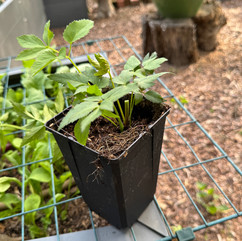Budget, Beginner, Bee & Bouquet Friendly: Golden Alexanders
- Nuts for Natives
- Apr 30
- 3 min read
This native perennial does it all.

An Instagram post this week by Lillian Farms, and more about Lillian Farms later, featured golden alexanders (Zizia aurea) and got me thinking about the incredible benefits golden alexanders bestow.
Golden alexanders are spring blooming, three foot high perennials with yellow flowers. In my garden, they bloom from early April through June and then sporadically through the rest of summer. The umbel flower heads dry and remain upright most of fall. The foliage stays lush and strong and partially turns to a burgundy color in late fall and is often evergreen. It acts as a tall ground cover. Golden alexanders are also one of those plants that fills what some call the flower gap between spring and summer. It really does it all!

Budget Friendly
Golden alexanders spread. This makes them very budget friendly. You only need a handful of quart sized plants to get a patch like the one in front of my garden shed. The plants spread by growth and by seed. Two to three year old plants can easily be divided to create more.
After the flowers dry, it's easy to collect seeds which you can scatter on bare soil in fall or plant and nurture seeds in pots. But if you do neither of those, the seeds will spread on their own.

Golden alexanders do not spread aggressively in my experience. The patch in front of the shed creates a handful of new plants each year. This year's crop is shown growing below the stone wall containing the golden alexanders. They are easy to dig up as the root systems of young plants are small. You can pot them up for friends or replant in another part of your garden. Every year this spot gets new plants from three species and by May, I have usually moved them to new locations.
If you want a patch of golden alexanders and start with those three quart sized plants and a little patience, before you know it, you will have that patch. Better yet, if you know someone who grows golden alexanders, ask if you can collect some seeds. In August or September, you can tap the dried flowers into an envelope and you will be amazed at how many seeds you get!
If you do dig up extra plants for friends, make sure to snip off the flowers to ensure the plant's energy goes into establishing a healthy root system.

Beginner Friendly
Golden alexanders are versatile in terms of light, moisture and soil, making them super easy to grow. They can take full sun, dappled shade or even full shade. Out in nature, they grow in moist areas but grow just fine in average and even dry soils. As for the type of soils, golden alexanders grow in everything from clay to very fertile soils. I have some growing in compacted fill type soil too. These are very adaptable plants and perfect if you are just getting started.
Bee Friendly
Golden alexanders attract an array of pollinators all day long. Dr. Doug Tallamy points out in his new book, How Can I Help?, golden alexanders are a host plant for the black swallowtail butterfly. That's pretty great!
Bouquets
Golden alexanders are great cut flowers, whether mixed into a bouquet or on their own. They produce so many flower stems once established that you won't even mind cutting an armful. If the flowers have already opened, give them a shake to release any loose pollen before taking them indoors. They are long lasting in a vase. If the vase runs dry and the flowers start to wilt, a fresh cut and fresh water will usually revive them.
Back to Lillian Farms! This is a relatively new nursery just starting out their second season in Beltsville, Maryland. They are small but mighty with about half of their inventory currently native. They have big plans to grow their own plants and increase their native percentages. And, yes, they are selling golden alexanders!
Happy Gardening.





































I've had black swallowtail caterpillars on my Golden Alexanders so I'm very happy to have this plant in my garden.
I just got some Zizia aurea in an attempt to hem in the lesser celandine that is making inroads in my yard. I've heard of using Packera aurea to hold the line on invasive plants, but am unsure about introducing packera and its vigorous growth to this part of my yard. I'll let you know if I'm successful!
I love my golden alexanders! I was just admiring how healthy and pretty they look this year, and I eagerly await the black swallowtail cats later in the season.